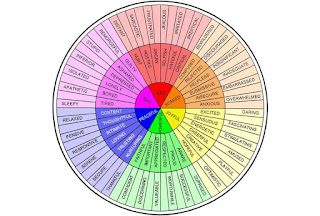In a flash I knew that the word was the name of the process that was going on in my head. This was my first conscious perception of an abstract idea... --H.K.
Feelings: Abstract processes of our perception of the world around us: Wikipedia partly defines feelings as follows:
The word was first used in the English language to describe the physical sensation of touch through either experience or perception. The word is also used to describe experiences other than the physical sensation of touch, such as 'a feeling of warmth' and of sentience in general... Perception of the physical world does not necessarily result in a universal reaction among receivers, but varies depending on one's tendency to handle the situation, how the situation relates to the receiver's past experiences, and any number of other factors. Feelings are also known as a state of consciousness, such as that resulting from emotions, sentiments or desires. (wikipedia)
 |
| Dr. Gloria Wilcox's Feelings Wheel, 2001 |
I'm at a loss for words: Feelings wheels and charts can be useful to help people find the right word to describe the abstract feelings they have in words that are understandable. Although these words do not always suffice, it is a start in identifying how we process some of the emotional cause and effect that makes us feel what we are in any given moment.
 Forgiveness is the key: While Wilcox's wheel seems to help in identification, other wheels seem to intend a process. The one to the left helping us to move from negative feelings to positive ones by progressing from shame through forgiveness to love. The similarities to Wilcox's wheel are evident, but there is a directional purpose offered here. There seems to be more judgement in this second wheel, with the hope for progress to a positive emotion. Although Wilcox hoped to help people move from negatives to positives, her wheel was for identification in that process, while this second wheel builds in it's purpose to help draw the observer "south" to love emotions away from shame emotions. While Wilcox implies that Isolated equals Lonely equals Sad, this second wheel seems to imply some causation: Lonely is an indication of being Abandoned which causes Shame.
Forgiveness is the key: While Wilcox's wheel seems to help in identification, other wheels seem to intend a process. The one to the left helping us to move from negative feelings to positive ones by progressing from shame through forgiveness to love. The similarities to Wilcox's wheel are evident, but there is a directional purpose offered here. There seems to be more judgement in this second wheel, with the hope for progress to a positive emotion. Although Wilcox hoped to help people move from negatives to positives, her wheel was for identification in that process, while this second wheel builds in it's purpose to help draw the observer "south" to love emotions away from shame emotions. While Wilcox implies that Isolated equals Lonely equals Sad, this second wheel seems to imply some causation: Lonely is an indication of being Abandoned which causes Shame.
Emotions are so complex; its about our perceptions of the world around us: Interestingly, as I searched for authorship of these wheels, or even the impetus behind their various constructions (finding little, by the way), I kept discovering variations on the theme. This next wheel seems to combine the two wheels above for a much larger and complex set of offerings:
 Peacefully Artful Displays of Rocks: Good writing is about people, I think; People who feel real. And it is in our complexities and abstractnesses that we establish ourselves in this world uniquely as what we are. Our complexities and abstractnesses make us so much more interesting than say, a pile of artfully displayed rocks (although rocks can be delightfully interesting to look at and described, there is little room for development or transformation there). So below I offer Kaitlin Robbs' feelings wheel for your perusal, amusement, and illumination. Use it as you wish...
Peacefully Artful Displays of Rocks: Good writing is about people, I think; People who feel real. And it is in our complexities and abstractnesses that we establish ourselves in this world uniquely as what we are. Our complexities and abstractnesses make us so much more interesting than say, a pile of artfully displayed rocks (although rocks can be delightfully interesting to look at and described, there is little room for development or transformation there). So below I offer Kaitlin Robbs' feelings wheel for your perusal, amusement, and illumination. Use it as you wish...



No comments:
Post a Comment